crypto-MUSEUM
이승현展 / LEESEUNGHYUN / 李升鉉 / drawing
2010_0722 ▶ 2010_0829
-
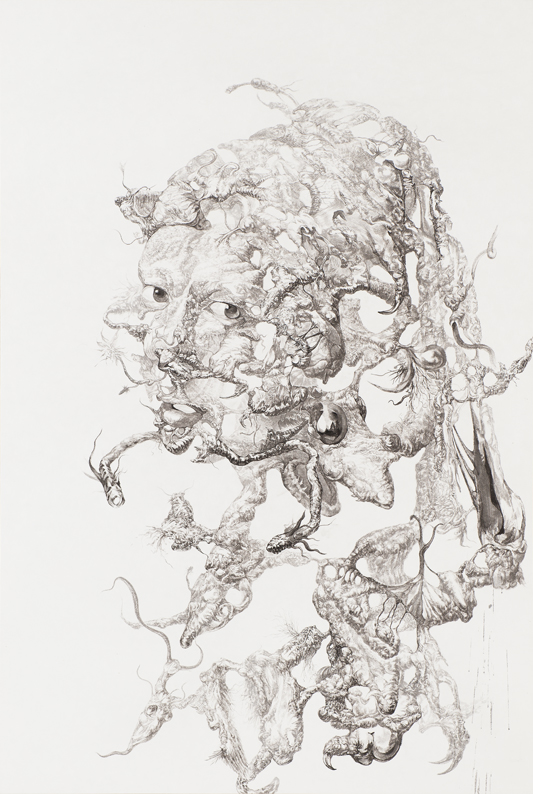
Masterpiece virus 012 장지에 먹 193×130cm 2010
초대일시_2010_0722_목요일_06:00pm
관람시간 / 9월~3월_11:00am~07:00pm / 4~8월_11:00am~09:30pm
갤러리 잔다리_GALLERY ZANDARI
서울 마포구 서교동 370-12번지
Tel. +82.2.323.4155 +82.2.323.4155
www.zandari.com
자율적 '그리기'에 점령당한 명화 ● 여기 정체를 알 수 없는 기이한 생명체가 침투해 증식 하고 있는 명화들이 전시된 '실재(實在)하는 가상의' 미술관이 있다. 「명화 바이러스(Masterpiece virus)」라는 제목의 그림들은 레오나르도 다 빈치, 베르미어, 마네, 피카소, 반고흐 등 시대를 망라한 서양의 대표적 화가들의 유명작품이지만 정체불명의 생명체가 잠식해 그 형태를 알아보기조차 힘들다. 어디선가 본 듯한 낯익은 이 생명체들은 과거 서울의 몇몇 전시장에 출몰한 바 있어 이미 미확인동물학계의 일부 학자들에게 연구의 표적이 되고 있다. 특히 「미확인미술관(crypto-MUSEUM)」이라는 이름 아래 현존하는 「명화 바이러스」가 한 자리에 모인 것은 이번이 처음이어서 미술계 안팎의 이목 또한 집중될 것으로 보인다. ● 이승현의 이번 전시 「미확인미술관」에 대한 이 설명은 사실이면서 사실이 아니기도 하다. 「미확인미술관」과 「명화 바이러스」는 분명 실재하지만 그 안에 자라나고 있는 기이한 생명체는 가상의 것이다. 그러나 그 역시 온전히 가상인 것만은 아니어서 그림 안에 현재 생명체가 자라나고 있음은 사실이 아니지만, 과거에 그림의 표면 위에서 무언가 자라났던 것만은 사실이다. 생명체 형태의 그것들은 분명 작가의 손끝에서 나왔지만 작가의 통제 범위를 넘어서 자율적으로 증식된 것이기에 "자라났다"는 표현이 매우 적절하다. 또한 미확인동물학계에서 이 생명체를 연구의 표적으로 삼고 있음은 사실이 아니지만 작가가 미확인동물학에 관심을 갖고 있는 것은 사실이며, 이전까지 간간이 보여주었던 「명화 바이러스」 연작을 모아 그것들로만 구성된 전시를 처음 선보이는 것 역시 사실이다. 이렇듯 이승현의 작업 전반은 가상과 실재를 비롯한 상반되는 것들 사이의 끝없는 미끄러짐으로 이루어져 있다.
-
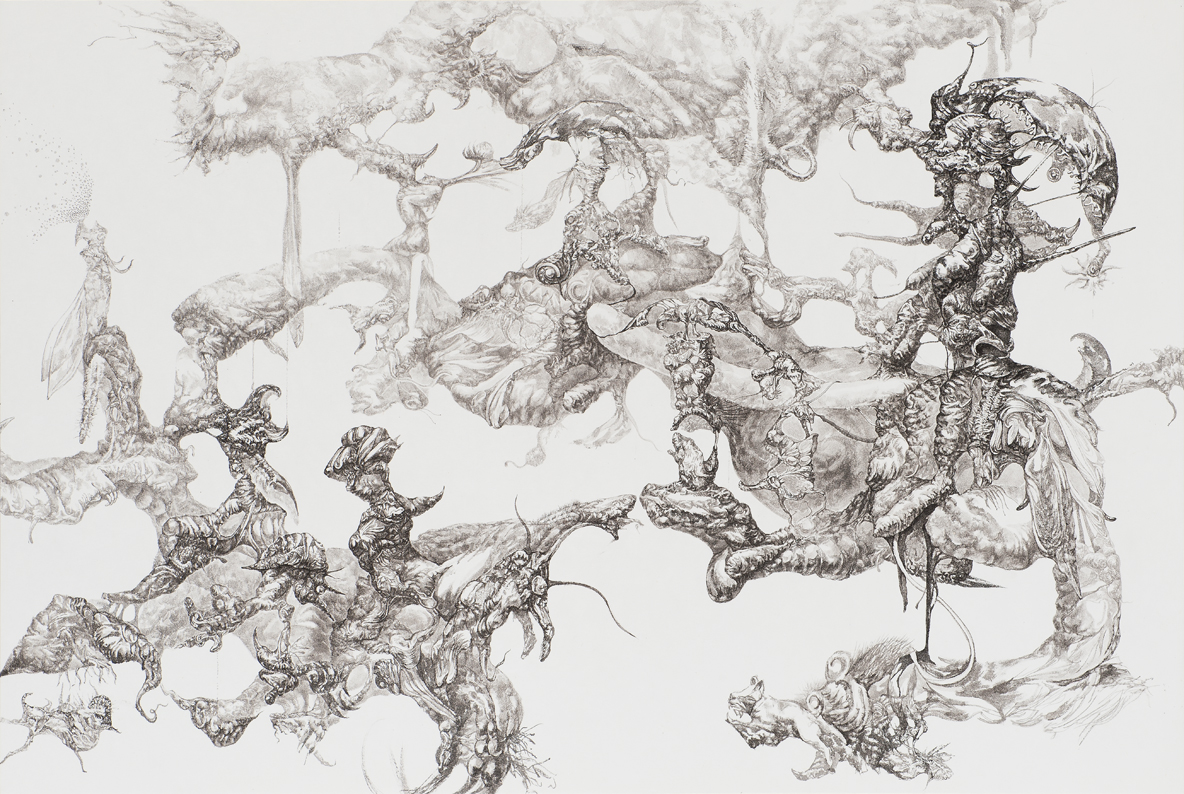
Masterpiece virus 010 장지에 먹_135×202cm 2010
모든 것의 실마리는 정체불명의 생명체로 향한다. 현재 「명화 바이러스」에 침투해 서식하고 있는 것도 그 밖의 작가의 다른 작업을 지배해온 것도 다름 아닌 그 생명체이기 때문이다. 이승현의 그림 속 생명체는 정체를 알 수 없으면서도 어딘지 모르게 눈에 익숙하다. 각 작품마다, 또 보는 사람마다 그것들은 동물이나 식물, 혹은 동식물을 이루고 있는 세포단위나 미생물 등으로 각기 다르게 보인다. 분명한 것은 그 형상들로부터 우리는 그것이 무엇이 든 간에 어떠한 생명체를 연상하게 된다는 사실이다. 그러나 작가는 어떠한 대상도 묘사하거나 재현하지 않았다. 그럼에도 불구하고 우리는 그림에서 언제나 구체적인 대상을 발견하려는 환영(illusion)에 대한 관습과 지각체계의 연상작용으로 인해 그 형상들을 특정한 대상으로 인식하게 되는 것이다. 여기에 이 생명체의 특이한 존재적 층위가 암시되어 있다. 이는 애초에 생산자(작가)가 지시체를 상정하는 일반적인 기호와 달리 정해진 지시체가 없는 기호로서, 그것은 동일한 기표에도 불구하고 수용자(관객)에게 계속해서 다른 기의로서 미끄러진다. 우리는 그의 그림에서 계속하여 저마다 다른 미확인 생명체를 발견하려 하기 때문이다. ● 이러한 지시체가 부재한 기호로서 이승현의 미확인 생명체가 갖는 특이한 존재적 층위는 그것이 생성되는 방식에서 비롯된다. 무엇을 어떻게 그리겠다는 계획이나 의식도 없이 온전히 '그리기'라는 행위에만 몰두하여 주어진 공간 안에서 작가의 손끝을 따라 확장되는 자율적인 생성과정이 바로 그것이다. 물론 형상을 만들어내는 것은 작가이지만, 그것은 작가가 화면에 전혀 새로운 것을 창조해내고 통제할 수 있다는 전통적인 의미에서의 창조와는 분명 다르다. 흡사 어디엔가 원래 존재하고 있던 무언가가 작가의 손끝을 타고 내려와 화면에 안착하는 것처럼 작가는 그 일련의 흐름에 자신을 내어준다. 이승현의 그림 속 형상은 재현도 아니지만 순수한 창조도 아닌 형식적 자율성에 의존하여 생성된 고유한 위치를 점한다.
-
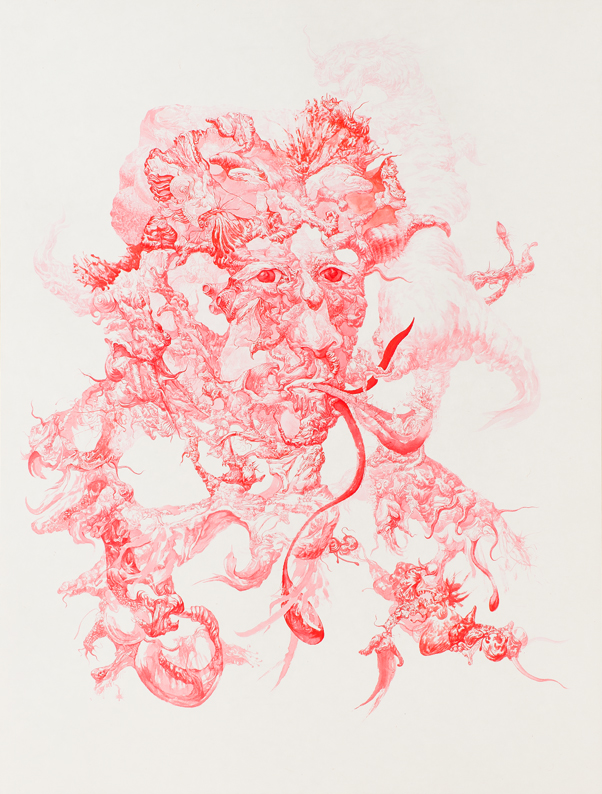
Masterpiece virus 007 장지에 주묵 190×145cm 2009
그의 작업의 정체성을 규정하는 이러한 핵심적인 특징은 그의 작가로서의 출발지점과 맞닿아 있다. 회화의 모든 원칙과 관습이 자신을 옭죈다는 생각이 들던 어느 시점, 그는 회화에서 모든 것을 제거하고 남는 것이 무엇일까 고민하게 되었고 결국 '그리기'라는 최소한의 요소로부터 모든 것을 다시 시작하게 된다. 빈 캔버스에 어떠한 계획도 없이 최초의 붓질을 가하고 그 흔적에 따라 다음의 붓질을 이어감으로써 유기적 형태를 완성한 것이다. 무엇인가를 형성해나가기 위한 번식에 초점을 맞춘 「유형생식(formative reproduction)」이라는 제목의 이러한 초기 회화가 바로 오늘날 그의 작업의 모태가 되었다. 그리고 이후 캔버스와 붓이라는 재료의 굴레마저 벗어던진 채 오로지 '그리기'라는 행위 자체에 집중하여 종이에 볼펜으로 선을 긋는 일상의 '끼적거림'으로부터 지금의 작품 형태가 드러나기 시작했다. 선이 반복되고 중첩되면서 농담과 명암이 나타나고 우연적인 형상이 탄생했으며, 하나의 형상이 인접한 다른 형상과 연결되면서 생명체를 연상시키는 일련의 구상성이 생겨난 것이다. 선이라는 추상적 요소의 반복과 증식을 통해 비로소 구상성을 획득하게 되는 셈이다. 뿐만 아니라 그 형상이 일종의 생명체로 인식되는 이유 역시 형식적 특징에서 비롯된다. 일체의 기구를 쓰지 않는 그의 '그리기'에서 직선은 길이와 정밀함의 한계가 있기에 자연스럽게 곡선을 사용하게 되고, 곡선을 계속하여 연결하고 변형함으로써 전반적으로 유기체의 인상을 주는 형상이 생겨나는 것이다. 결과적으로 작가의 손을 거친 곡선의 자율적인 증식은 특정한 종(種)이나 군(群)의 생명체를 직접적으로 묘사하지 않았음에도 흡사 생물이 번식하는 것과 같은 생명성을 부여하게 된다. 이 생명체는 그간 「N.C(New Creature)」, 「몬스터(Monster)」, 「미확인동물학(Cryptozoology)」, 「가변증식체(adjustable proliferator)」 등의 이름으로 변형, 발전되어 왔다. 그 제목에서도 알 수 있듯 그의 그림 속 생명체들은 실제 존재하거나 적어도 작가의 상상 속에서 비롯된 것처럼 보이지만, 실상은 선의 자율적 확장에 의해 탄생한 우연적 결과에 불과하다. 이렇듯 이승현의 그림은 매우 구체적인 생명체의 형상이 실상은 추상적인 형식성에 존재 근거를 두고 있다는 양자의 간극에 묘한 매력이 있다. ● 선의 무한 반복과 자율 증식으로부터 탄생한 이승현의 이러한 미확인 생명체는 무엇보다 특정한 영역에 정착함으로써 그 진가를 발휘하게 된다. 현재까지 그 두드러진 활약은 '공간'과 '명화'에서 나타났다. 그것은 마치 새로운 생명체가 성장하여 자신의 역할을 다 하며 삶을 살아가는 과정과도 같이 자연스럽게 진행되었다. 먼저 그의 미확인 생명체는 구체적인 실제 공간을 만났을 때 본연의 모습을 잘 드러낸다. 일단 하나의 점에서 시작되기만 하면 공간에 자연스럽게 스며들거나 공간의 성격을 바꾸어가며 주어진 환경에 맞추어 급속도로 성장해나가기 때문이다. 카페 테이크아웃드로잉에서의 「미확인동물원」이나 철거 직전 학교 작업실에서의 「퍼레이드(parade)」가 그 좋은 예다. 「미확인동물원」에서 작가는 카페의 전면 유리와 내벽 전체에 한 달 동안 이 미확인 생명체를 증식시켰고, 이후 완성된 상태로 한 달 동안 카페의 손님을 맞이하였다. 작가는 흰색 마커를 사용하여 특정한 한 지점에서 시작해 전체 공간으로 '그리기'를 확장해 나갔다. 작가 자신조차 그 생명체가 어떠한 형태와 방향으로 확장될지 모른 채 증식은 이루어졌으며, 한 달 동안 카페를 찾는 손님과 카페 직원들이 그 증식과정의 목격자가 되었다. 한편 「퍼레이드」는 작가가 사인펜, 매직, 분필 등을 사용하여 철거가 예정된 학교 작업실 벽의 갈라진 틈으로부터 벽면, 블라인드, 환풍기, 칠판 등 주어진 공간을 가로지르며 생명체의 증식을 목도(目睹)한 작품이다. 작가는 건물이 철거되기 전 생명체가 자리했던 합판 벽면과 그 밖의 부수적인 요소들을 그대로 뜯어내 보관하였다가 이후 몇 차례 미술관 전시에서 재배치하여 보여준 바 있다.
-
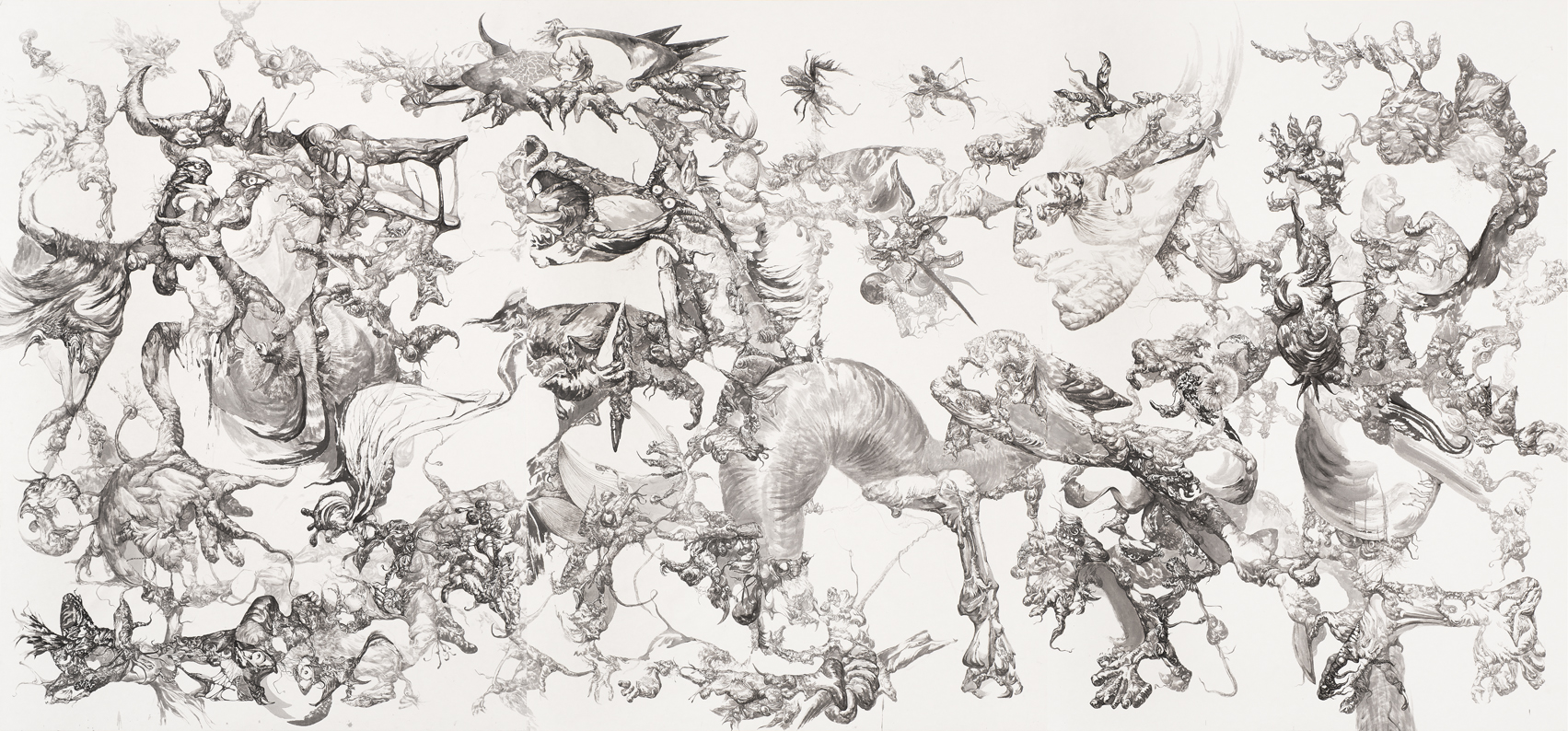
Masterpiece virus 009 장지에 먹 243.5×525.5cm 2010
-
한편 이승현의 미확인 생명체가 정착하여 자라나는 또 하나의 세계는 바로 서양미술사의 대표적인 명화들이다. 물리적인 실제 공간과는 다르게 명화는 우리의 의식을 지배하고 있는 하나의 이미지로서 비물질적인 영역에 해당한다. 여기에는 조금 더 상징적인 의미작용이 부가되는데 모두에게 익숙한 명화의 이미지에 미확인 생명체를 침투시켜 일종의 바이러스처럼 퍼져나가게 함으로써 명화의 고정된 질서에 균열을 가하고자 하는 의도가 숨어 있는 것이다. 이는 이 그림들이 따르고 있는 회화의 전통적인 관습과 규칙에 대한 도전이자, 이들 명화로 상징되는 미술계의 절대적인 권력과 제도에 대한 거부의 표현이다. 동시에 그 이면에는 이십대 후반 미술을 처음 시작한 작가에게 이 명화들이 주었을 지대한 영향과 강한 존재감을 드러내는 반어적 표현이기도 할 것이다. 한편 공간작업과 「명화 바이러스」는 물질과 비물질의 존재적 토대의 차이 외에도 작가의 '그리기' 행위에 주어지는 한계와 방식에서 큰 차이가 있다. 공간작업의 경우 주어진 환경 안에서 행해지면서도 작가의 손길이 닿는 대로 뻗쳐 나가는 극도의 자율성이 부과되지만, 명화 작업은 그와 정반대로 윤곽과 최소한의 형태를 정해 놓은 뒤 주어진 범위 안에서 그려나가야만 하기 때문이다. 이는 공간작업에 주어졌던 지나친 자율성에 대한 반작용으로서 한정된 틀 안에서의 '그리기' 방식을 실험하기 위해 작가 자신이 의도적으로 부여한 한계다. 미리 한계를 설정한 이러한 '그리기' 방식은 그 자체로 단단하게 고정된 질서를 지닌 명화라는 소재에 잘 부합하는 형식이며, 명화 이미지가 가진 구상성에 작가 고유의 추상적인 '그리기' 행위를 결합함으로써 생겨나는 우연적인 결과를 지켜보고자 하는 의도를 담고 있다. ● 명화에 침투한 이 미확인 생명체는 그림마다 각기 다른 양상으로 확산되고 정착하여 기이하고 이물스러운 모습으로 명화의 기존 질서를 뒤흔든다. 반 고흐의 「자화상」과 베르미어의 「진주귀걸이를 한 소녀」의 얼굴은 사방으로 흩어지기 시작했으며 여기저기 촉수가 자라고 있다. 마네의 「피리부는 소년」과 베르미어의 「우유 따르는 하녀」처럼 배경이 먼저 완전히 잠식되어 사라지고 인물들로 생명체가 옮겨온 지 얼마 되지 않은 듯 아직 형상을 알아볼 수 있는 것들이 있는가 하면, 고흐의 「별이 빛나는 밤」이나 쇠라의 「그랑자트 섬의 일요일 오후」처럼 배경은 물론이고 형상들에까지 생명체가 파고들어 그 형체를 알 수 없게 된 경우도 있다. 한편 생명체의 양태도 다양하다. 피카소의 「아비뇽의 처녀들」처럼 곤충이나 갑각류를 연상케 하는 좀 더 파편화된 형상도 있고, 보티첼리의 「비너스의 탄생」이나 미켈란젤로의 「죽어가는 노예」처럼 근육의 결이나 조직의 변이가 강조된 동물성의 양태가 있는 반면, 고흐의 「오베르 교회」나 「고흐의 방」처럼 전체적인 형상이 중력 방향으로 뿌리내리는 듯한 식물성의 인상이 강한 경우도 있다. 생명체의 양태나 해체의 진행 정도가 다르긴 하나 이들 모두는 각각의 이미지를 겨우 식별할 수 있을 정도의 윤곽과 주요 특징 외에는 온통 정체불명의 생명체에 의해 점령당해 그야말로 초토화된 상태다. 이러한 일군의 「명화 바이러스」가 모여 있는 「미확인미술관」에 들어선 관객은 이제껏 고귀하고 아름답다고만 여겨왔던 명화들이 제 멋대로 일그러지고 괴기스럽게 변형된 모습에 당황하거나 불편해 할지 모르며 반대로 묘한 쾌감을 느낄 수도 있다.
-
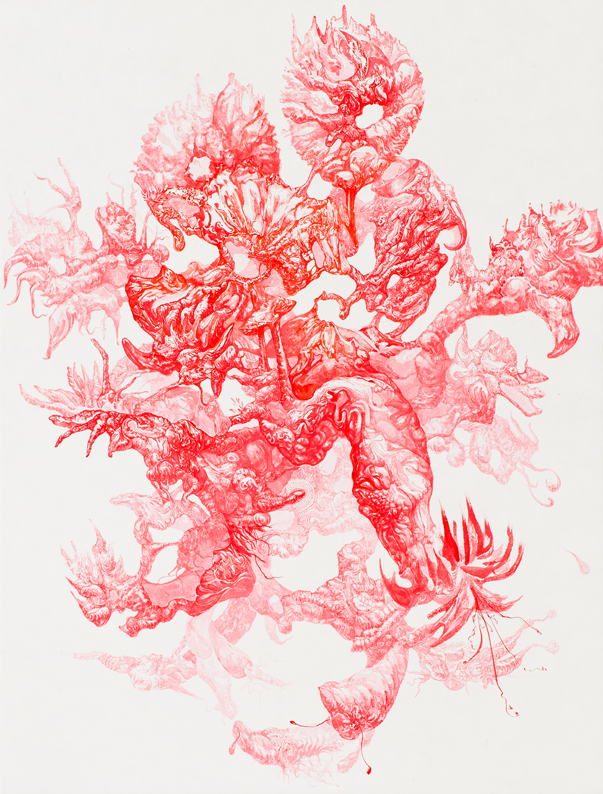
Masterpiece virus 014 장지에 주묵 107×81cm 2010
-
한편 「명화 바이러스」는 서양 명화의 이미지를 장지에 먹이라는 동양화의 재료를 사용해 변형시키는데서 오는 간극이 낯설고 묘한 정서를 불러일으킨다. 응당 유화로 그려져야 할 명화의 이미지가 단색의 먹으로 그려짐으로써 미확인 생명체들에 의해 형태의 변이뿐 아니라 색채의 약탈마저 일어난 것 같은 인상을 주기 때문이다. 「명화 바이러스」에 처음으로 쓰인 동양화의 재료는 이러한 명화라는 '소재'와의 관련성뿐 아니라 기존 작업들과의 형식상의 차이를 염두 하여 살펴볼 필요가 있다. 볼펜, 사인펜, 매직 등 주변에서 흔히 구할 수 있는 필기구로 시작된 그의 작업은 정밀성과 보존의 문제로 가늘고 잘 변하지 않는 로트링펜으로 옮겨갔다. 그러나 엄청난 노동량으로 손목에 문제가 생겨 재료를 바꿔야 될 필요를 느꼈고 이 때 상대적으로 손목에 무리가 덜 가는 붓을 생각하게 된 것이다. 또한 먹과 붓은 펜과 달리 원하는 대로 두께와 농담을 조절할 수 있어 선만으로 명화 이미지의 입체적 형상과 깊이의 환영을 나타내기에 적합한 수단이었다. 이승현의 그림에서 먹과 붓은 동양화의 전통적인 필법과는 상관없이 그 물질적 본성을 따라 자유롭게 사용함으로써 새로운 형식적 표현을 가능케 하는 온전히 하나의 재료로써 선택된 셈이다. ● 이렇듯 이승현의 「명화 바이러스」는 재료, 소재, 형태 모든 면에서 생명체가 자라듯 자연스러운 행로를 따라왔다. 그것은 대중에게 익숙한 상투형의 이미지를 차용하고 있는 까닭에 자칫 팝아트의 지류(支流)로 분류될 수 있지만, 그러한 해석은 그 외양만을 읽는데서 비롯된 일일 것이다. 「명화 바이러스」는 우연과 자율성에 의존한 작가의 '그리기'로부터 생겨난 생명체가 특정한 영역에 정착한 하나의 형태로서 일련의 그의 전(全)작업 중 일부분에 해당할 뿐이기 때문이다. 따라서 「명화 바이러스」는 그의 작업 전반을 관통하는 상반되는 것들 사이의 유희라는 고유한 특징의 연장선상에서 파악되어야 한다. 작가의 상징처럼 여겨지는 '미확인동물학'이 정밀함을 전제로 하는 하나의 학문 분야이면서도 목격자들의 증언에 기반하여 생물체를 추적하는 초자연적인 성격을 동시에 지니고 있는 것처럼 말이다. 그의 미확인 생명체는 앞으로 또 어떠한 구체적인 세계에 정착되어 어떠한 모습으로 증식할지 모른다. 그러나 그것은 실재와 가상, 구상과 추상, 결과와 과정, 노동력과 상상력, 동물성과 식물성, 서양과 동양 등 상반된 것들 사이의 미끄러짐과 균형을 견지(堅持)할 것이며 그 보다 앞서 작가로서의 진지한 태도를 수반할 것임에 틀림없다. 그가 "미확인(crypto)"이라는 접두어를 내려놓지 않는 것 역시 그것이 "아직은 확인되지 않았으나 앞으로 확인될 수도 있다"는 이중성을 함축하는 단어이기 때문일 것이다. ■ 신혜영
-
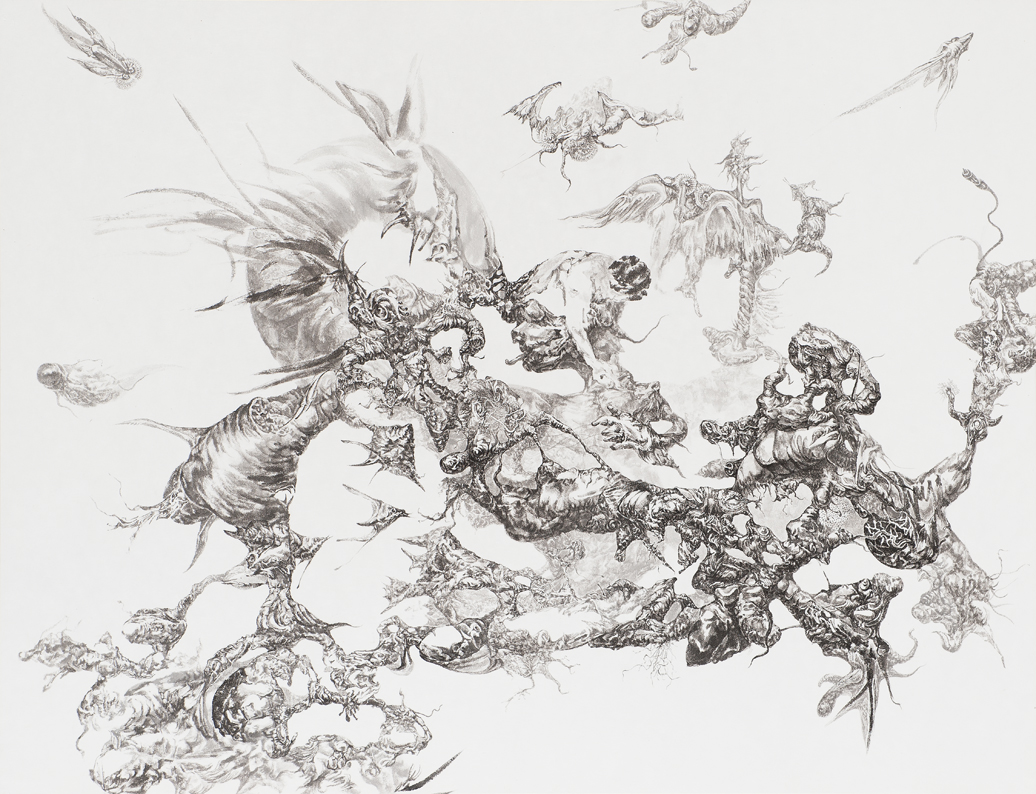
-
Masterpiece virus 011 장지에 먹 135×177cm 2010
-
-
-
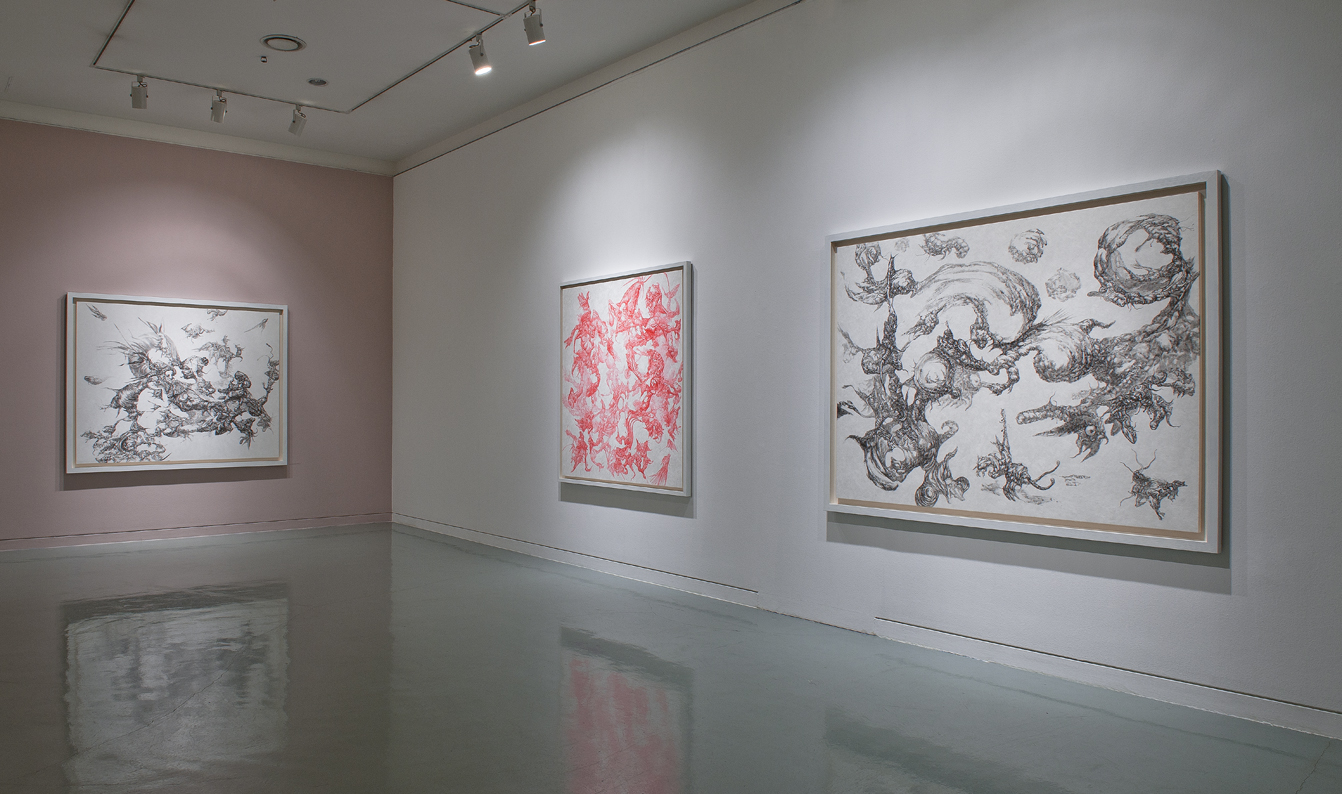
-
이승현展 갤러리 잔다리 2010 -
-
A masterpiece occupied by the autonomous 'Drawing' ●Here is a 'virtual museum in realty' where masterpieces infiltrated and propagated by unknown eccentric organisms are exhibited. Under the title 「Masterpiece virus」, the paintings of prestigious artists such as Leonardo Da Vinci, Johannes Vermeer, Edouard Manet, Pablo Picasso and Vincent Van Gogh are unrecognizable because alien viruses pervaded into them. However, as these somewhat familiar organisms have emerged in some art galleries in Seoul, they are becoming the study target of some scholars in the academic circle of cryptozoology. In the meantime, under the name of 「crypto-MUSEUM」, the works of 「Masterpiece virus」 are put together for the first time, which will attract much attention in the art world and beyond. ● This description of the artist Lee, Seung-hyun's exhibition 「crypto-MUSEUM」 is true and not true at the same time. 「crypto-MUSEUM」 and 「Masterpiece virus」 are present in reality for sure, but the alien creatures growing in them are virtual. And yet, they are not totally virtual. Although life growing within the paintings is not real, the fact that something was evolving on the surface of the paintings is true. The life forms in the paintings obviously came from the fingertip of the artist, but "evolving" is a truly appropriate term as it proliferated spontaneously, beyond the artist's control. Moreover, in fact cryptozoologists do not pay attention to the organisms as a target subject, but it is true that the painter is interested in cryptozoology. It is also true that this is the first time to show all the series of 「Masterpiece virus」 which have been exhibited so far. Likewise, Lee's overall artwork involves the endless slippery between contrasts such as virtuality and reality. ● The clue to everything lies in crypto-organisms because they are the ones that have infiltrated and inhabited in the 「Masterpiece virus」 and dominated the artist's other works as well. The creatures in his paintings look somewhat familiar though we do not know where they come from. Depending on works or audiences, the organisms look different: the animal, plant, microorganism or cell, the basic unit of life. One clear thing is that whatever shape they have, they remind us of a form of life. However, the artist did not describe or represent any subject. Nonetheless, we recognize them as a certain object because of the illusionary convention in which we are expected to find a specific subject from paintings and the association process through the sensory perception. A unique existential position of these organisms is implied here. Unlike a general sign indicating a referent that the producer (artist) presupposes in the first place, this is a sign without a certain referent. Although this is the same signifier, it keeps slipping into a different signified to the receptor (audience). That is because we keep trying to identify crypto-organisms from paintings in our own way. ● The distinct existential position of the cryptic organisms, as a sign lacking this referent, originates from the way they are generated. Without any plan or intention on what and how to draw, the artist is immersed in pure 'drawing.' Accordingly, autonomous creation takes place through expansion along the artist's brush strokes within the given space. The creation work is in the hands of the artist, but it is different from the one in the traditional perspective of creating something new on the canvas and putting it under control. As if something that had existed somewhere appeared on the canvas along with the fingertip of the artist, he let himself be part of the flow. The image of Lee's paintings is neither a representation nor a pure creation. Rather, it takes a unique position based on formal autonomy. ● This core characteristic that defines the identity of his artwork is in line with the starting point of his career as an artist. At some point when he feels all principles and customs of paintings confine him, he considers what is left after removing all elements from paintings and goes back to basics - 'drawing.' On a blank canvas, he applies the first brush stroke with no specific intention and then another stroke along the trace, completing an organic shape in the end. His early works under the title of 「Formative reproduction」 with the focus on propagation to form something have laid the foundation for his recent artwork. Since then, he has concentrated on the action of 'drawing' free from the constraints of materials such as the canvas and paintbrush and today's works have emerged from 'doodling' (drawing lines on paper with a ball-point pen) in daily life. As the lines were repeated and overlapped, light and shade appeared and an unexpected shape was created. Finally, a series of representational images reminiscent of life forms were generated as an image was associated with an adjacent image. In other words, through the repetition and proliferation of the abstract factor (lines), concrete imagery is obtained. The image is recognized as a life form because of its formative feature. In his 'drawing' in which no device is used, straight lines have limits in terms of length and precision and thus curves are employed. The continuous connection and modification of curved lines offers an impression of an organism on the whole. As a result, the autonomous proliferation of curves through the artist's hands instills vitality as if a life were growing, though no specific species or fauna were directly depicted. This organism has mutated and evolved under the names of 「N.C (New Creature)」, 「Monster」, 「Cryptozoology」, 「Adjustable proliferator」. As you can infer from the titles, the life forms in his paintings appear to be existent in reality or derived from the creator's imagination. In fact, however, this is a mere coincidence, resulting from the free-flowing expansion of lines. In this regard, Lee's works of art are intriguing in that the concrete imagery of creatures originates from abstract forms. ● When the unidentified organisms, which were derived from the indefinite repetition and autonomous proliferation of lines, settle in a certain territory, they prove their real values. So far, they have been outstanding in 'space' and 'masterpieces.' It looked like a natural process in which a new organism grows and lives to serve its purpose of life. First, the crypto-organism reveals itself when encountering a real space, for it smoothly permeates into a space or evolves rapidly according to the given environment by transforming the nature of the space once it begins from a dot. 「The unidentified zoological gardens」 in a cafe called 'Takeout Drawing' and 「Parade」 in a school studio just before destruction are good examples. In 「The unidentified zoological gardens」, the artist multiplied this unidentified life on the glass facade and internal walls in the cafe for a month. When the work was completed, the cafe was open to have customers for a month. The painter expanded the 'drawing' work from a certain point to the entire space, using a white marker. Even the artist himself had no idea what shape and direction the creature would stretch out. For one month, customers and cafe employees witnessed the proliferation process. Meanwhile, in the 「Parade」, the artist used pens, markers and chalks and saw a life reproducing while penetrating the wall, blind, ventilator and chalkboard from the cracks in the wall of the school studio that was scheduled to be demolished. Lee kept the plywood of the wall and other parts where the creature was evolving taken off before dismantlement and exhibited them in museums several times after rearrangement work. ● Another world where his mysterious life forms evolve is the masterpieces of Western art. Unlike a physical space in reality, masterpieces belong to the non-physical domain as imagery that dominates our consciousness. In addition to that, a more symbolic meaning is added - a hidden intention to disrupt the strict order of masterpieces by inserting a cryptic organism in the familiar image of the masterpieces and spreading it like a virus. This is defiance against traditional customs and rules of paintings that these masterpieces comply to, and revolution against the absolute authority and institution of the art world that is symbolized by these masterpieces. At the same time, beneath, this is an ironic expression of the great influence and strong presence that the masterpieces must have given to the artist who engaged in art in his late twenties. In the meantime, besides existential (physical or non-physical) foundations, 'spatial work' and 「Masterpiece virus」 have big differences in terms of the limitation and method of 'drawing.' Spatial work allows the artist considerable freedom to stretch out as much as his hands can get despite the given environment. By contrast, in the 「Masterpiece virus」 work, drawing is confined within a given range after determining at least outline and shape. This is the boundary that the artist himself drew intendedly in order to experiment the method of 'drawing' within a limited frame, as a reaction to the excessive autonomy given for spatial work. This way of 'drawing' is an appropriate style for masterpieces with strict principles. And the purpose here is to get accidental results by combining figurative images of masterpiece with the artist's own abstract 'drawing' action. ● The crypto-organism infiltrating in the masterpieces mutate into different forms and settle, resulting in eccentric and bizarre images and, accordingly, disrupting the conventional order. The faces in Van Gogh's 「Self-portrait」 and Vermeer's 「Girl with a Pearl Earring」 scattered to every direction and tentacles are growing here and there. In Manet's 「The Fifer」 and Vermeer's 「The Milkmaid」, the background submerged and disappeared and people are unrecognizable as if the creature just pervaded into them. Meanwhile, Van Gogh's 「Starry Night」 and Seurat's 「Sunday Afternoon on the Island of La Grande Jatte」, the organism permeated into not only the background but people, making everything unidentifiable. The creature takes various forms. It looks like a fragmented insect or Crustacean in Picasso's 「Les Demoiselles d'Avignon」. Botticelli's 「The Birth of Venus」 and Michelangelo's 「Dying Slave」 show the patterns of animals such as the texture of muscles or mutation of body tissues, whereas Van Gogh's 「The Church at Auvers」 and 'Van Gogh's 「The Bedroom」 illustrate that plants try to take root in the direction of gravity. Although the form of life or extent of the destruction progress differs, all of them, aside from contours and major characteristics that make images barely identifiable, are in a devastating state by being dominated by unidentified living creatures. When the audience enters 「crypto-MUSEUM」 filled with 「Masterpiece virus」 works, they may feel embarrassed or uneasy at the sight of the distorted and freakishly mutated images of the noble and beautiful masterpieces, or some may experience a strange pleasure. ● In the meantime, 「Masterpiece virus」 causes a queer sensation by applying Oriental materials such as a Korean traditional paper and ink to the images of Western art. Generally Western paintings are created with oil paints of various colors, but only one color (black or red) was applied, which gives an impression that the unidentified creature transformed shape and stole colors. We need to take a look at the materials of Oriental art used in 「Masterpiece virus」 in terms of the relation to the 'subject' - masterpieces - and formal differences from previous works. He first used ball-point pens, pens and markers that are easily found around us and then turned to Rotring Art Pens for precise and fine work and better conservation. However, he felt the need for a new material because he had a bad wrist after heavy labor and considered a brush that is relatively less burden for the wrist. Moreover, the traditional ink and the brush were the right means to express the three-dimensional shape of masterpiece images and illusion of depth only with lines because they are easy to control the thickness and light and shade as he likes, compared to pens. These drawing tools in his paintings were employed freely according to their physical properties regardless of traditional techniques of Oriental art, as a material to express a new style. ● All in all, Lee Seung-hyun's 「Masterpiece virus」 took a natural course in all aspects of material, subject and shape, as if a living organism grew. This might be categorized into a branch of Pop Art in that trite images, familiar to the general public, were borrowed. However, this interpretation comes from looking at only the surface of his work. 「Masterpiece virus」, in which a living creature derived from his 'drawing' based on coincidence and autonomy evolves and settles in a certain domain, is only a part of the artist's series of works. Therefore, we need to understand 「Masterpiece virus」 from a unique perspective - 'pleasure from contrasts' penetrating in his entire artwork. In other words, 'cryptozoology' - Lee's symbol - has both academic and supernatural attributes, as an academic field on the premise of precision, pursuing organisms based on witnesses' testimony. We do not know what world his crypto-organism will end up and how it will evolve in the future. However, it will strike a balance between contrasts - reality vs. virtuality, concreteness vs. abstraction, result vs. process, labor vs. imagination, animal vs. plant and the West vs. the East. And it will also require a serious attitude as an artist. The reason why the artist sticks to the prefix 'crypto' is that this term has a double meaning of 'unidentified yet but identifiable in the future' ■ Hye-young Shin